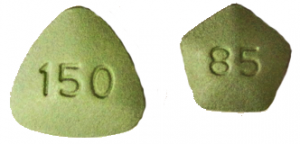Elvitegravir approved in EU: data on food and drug interactions
1 December 2013. Related: Antiretrovirals.
Simon Collins, HIV i-Base

Elvitegravir 150mg and 85 mg
On 18th November, the European Commission approved the integrase inhibitor elvitegravir as a separate formulation for use in combinations with a boosted protease inhibitor (PI). [1]
Approval is for use in HIV positive people who do not have genotypic resistance to elvitegravir.
Two formulations are available depending on the concomitant PI.
- The 85 mg tablet is for use in combinations that include atazanavir/ritonavir 300 mg/100 mg or the combined lopinavir/ritonavir 400 mg.
- The 150 mg tablet is for use with the ritonavir-boosted protease inhibitors darunavir 600 mg and fosamprenavir 700 mg.
Elvitegravir needs to be taken with food. The amount of type of food is not included in this recommendation but it may be important to include fat. The food interaction data in the SPC includes that elvitegravir AUC increased by 36% with a light meal (~373 kcal, 20% fat) and by 91% with a high-fat meal (~800 kcal, 50% fat).
- Drug interactions include with antacid medicines which can reduce levels of elvitegravir. Antacids need to be separated by at least four hours.
- Multivitamins also need to be separated from elvitegravir by at least four hours due to a potential interaction.
- Elvitegravir has the trade name Vitekta and is manufactured by Gilead Sciences. Elvitegravir is included in the fixed dose combination tablet Stribild (Quad) where it is boosted by cobicistat.
For further details see the Summary of Product Characteristics (SPC) posted to the EMA website. [2]
Comment
Although elvitegravir has not yet been approved in the US as a separate drug, a recent appendix added to the US DHHS guidelines included raltegravir, elvitegravir and dolutegravir equally as preferred first line options.
The food interaction data in the SPC was from a single-dose study. This mean C24h (%CV) values for elvitegravir under fasted, light meal or high fat meal conditions were 253 ng/mL (57%), 355 ng/mL (54%) and 488 ng/mL (66%), respectively. [3]
Although C24h values can be used to qualitatively compare concentrations across treatments, this cannot be used as a Ctrough (the most important parameter from the concern of drug resistance). Ctrough can only be determined from a multiple dose study after steady-state concentrations are achieved.
Although it is encouraging that the C24h was above the IC95 for elvitegravir (45 ng/mL) with all doses, the single-dose study is limited any to a conclusion that “expects elvitegravir Ctrough to be higher when administered with a meal compared to fasted”.
References:
- Gilead Press Statement. European Commission approves Gilead’s Vitekta, an integrase inhibitor for the treatment of HIV-1 infection. (18 November 2013).
http://www.gilead.com/news/press-releases - Elvitegravir Summary of Product Characteristics. European Medicines Agency (EMA) website.
http://www.ema.europa.eu/ema/index.jsp?curl=pages/medicines/human/medicines/002577/human_med_001710.jsp&mid=WC0b01ac058001d124
http://www.ema.europa.eu/docs/en_GB/document_library/EPAR_-_Product_Information/human/002577/WC500155576.pdf - German P et al. Effect of food on pharmacokinetics of elvitegravir, emtricitabine, tenofovir DF and the pharmacoenhancer GS-9350 as a fixed-dose combination tablet. 49th Interscience Conference on Antimicrobial Agents and Chemotherapy (ICAAC), 12-15 September 2009, San Francisco. Poster abstract A1-1300.
http://tinyurl.com/pn7zn8c

